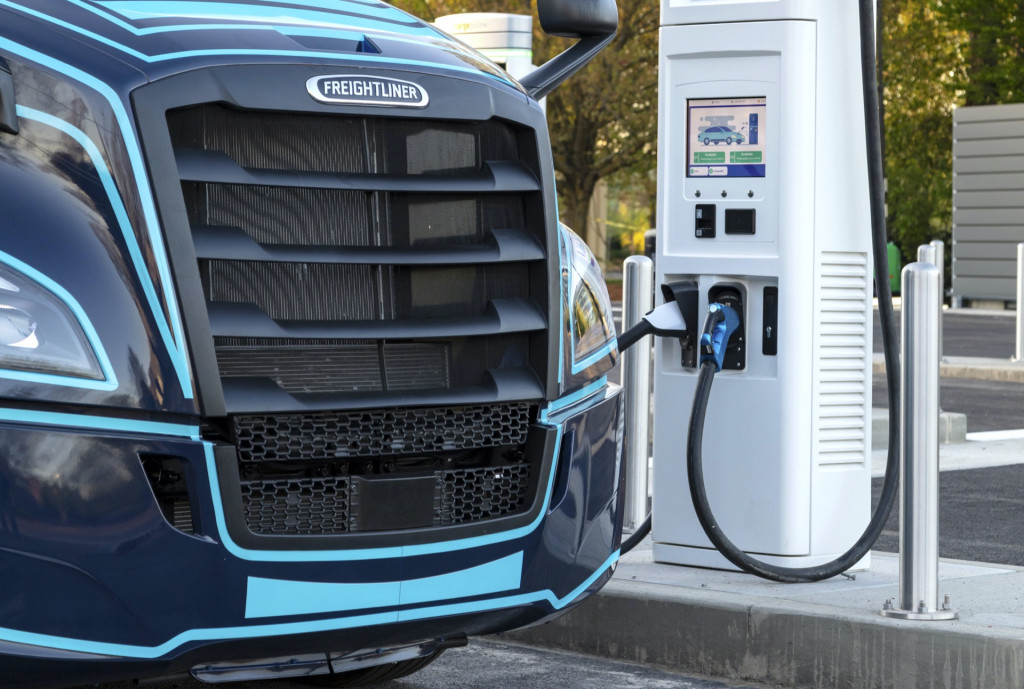[ad_1]
Fully electric heavy-duty trucks and buses aren’t going to be widely accepted until they can charge, as the standards group CharIn puts it, “within a reasonable time.”
This last week marked another important step, with the official inaugural demonstration (or simulation), at EVS35 in Oslo, of the higher-power hardware intended for that: the Megawatt Charging System (MCS).
CharIn is the standards-oriented trade group originally formed by the German automakers to refine and spur the adoption of the Combined Charging System (CCS).
First time I see a MCS charging plug!
(still prototype though and design still not finalized) by @ABBelec
Huge + and – terminals, ground, CP and PP pins and two extra…(for automation?🤔)
MCS standard upto 3.75MW power for trucks and buses. #EVS35 pic.twitter.com/7gYO20RKl7— Roberto di Gento (@robertvg) June 12, 2022
With battery packs for long-range electric semis expected to be in the hundreds of kilowatts, rapid charging will potentially take much more than the 350-kw power that’s the upper end of today’s CCS passenger-vehicle connector. As CharIn summed, more current requires more copper and larger conductor cross sections.
To that, MCS will use a single conductive plug, with a maximum of 1,250 volts and 3,000 amperes, and it will be “cyber-secure” and OSHA, FCC, and UL certified. There will be an on-handle override switch, and charge ports will be at about hip height on the left side of the vehicle—offering the capability to be automated in the future. It will offer bidirectional (V2X) charging capability.
Although, as we dare point out, if EVs with a small camping trailer—or GMC Hummer EVs—have trouble maneuvering into the typical Electrify America charger, the idea of an MCS-equipped RV trying to charge up there is a next-level hurdle.

Electric Island – Daimler Trucks North America and PGE – Portland OR
One of the first megawatt-capable charging stations to offer the MCS connector is Portland’s Electric Island site, developed by PGE and Daimler Trucks North America. It’s ready for a range of heavy-duty electric trucks.
Megawatt charging stations for trucks present even tougher challenges for siting, because they not only need to make room for the trucks but be at a point in the grid that can support the power draw (10 MW or more) of a semiconductor plant.
Those are among the tough questions that a group has tackled in laying out the plan for a “West Coast Clean Transit Corridor,” looking at where such stations might be sited and how to get started.
Another template for that may be a megawatt-level truck stop planned by the startup WattEV in Bakersfield, California, aiming for 40 charging stalls and 25 MW.

WattEV electric truck stop rendering
The final standards have been anticipated for a long time. CharIn reached a consensus in the design of inlets and connectors in September 2020. From that point—or earlier in the project—it was determined that MCS would be reverse-compatible with CCS. CharIn maintains that vehicles with MCS should also “be able to charge from the existing CCS infrastructure”—simply with some kind of plug adapter, we’d assume.
Tesla has also been at least somewhat allied in this effort for its upcoming Semi, noting that it’s looking to deploy megawatt-charging infrastructure with other parties, which we assume would converge on this same standard.
The standard, which we’ll dive into in more depth soon, should help provide more predictable charging behavior versus what truckmakers have in the interim resorted to—providing multiple CCS ports.
MCS aims to allow trucks and buses to charge “within a reasonable time,” and focuses on Class 6, 7, and 8 commercial vehicles. But as CharIn points out, it will help further not just electric trucks but also heavy-duty marine, aerospace, mining, and agriculture applications—as well as VTOL (vertical take off and landing) vehicles and other air vessels.
[ad_2]
Source link




